Verification of High-Resolution Medium-Range Precipitation Forecasts from Global Environmental Multiscale Model over China during 2009–2013
Abstract
1. Introduction
2. Data and Method
2.1. Data
2.2. Study Domain
2.3. Evaluation Metrics
3. Results
3.1. Spatial Distribution of Forecast Skill
3.1.1. Forecast Skill of Precipitation Categories
3.1.2. Spatial Distribution Characteristics
3.2. Temporal Distribution of Forecast Skill
3.2.1. Monthly Variations
3.2.2. Forecast Skill in Flood and Non-Flood Season
4. Discussion
4.1. Performance Comparison with GFS
4.2. Overview
5. Conclusions
Acknowledgments
Author Contributions
Conflicts of Interest
References
- Krzysztofowicz, R. The case for probabilistic forecasting in hydrology. J. Hydrol. 2001, 249, 2–9. [Google Scholar] [CrossRef]
- Biondi, D.; Luca, D.L.D. Performance assessment of a Bayesian Forecasting System (BFS) for real-time flood forecasting. J. Hydrol. 2013, 479, 51–63. [Google Scholar] [CrossRef]
- Liu, D.; Li, X.; Guo, S.; Dan, R.; Chen, H. Using a Bayesian Probabilistic Forecasting Model to Analyze the Uncertainty in Real-Time Dynamic Control of the Flood Limiting Water Level for Reservoir Operation. J. Hydrol. Eng. 2015, 20, 4014036. [Google Scholar] [CrossRef]
- Ciupak, M.; Ozga-Zielinski, B.; Adamowski, J.; Quilty, J.; Khalil, B. The application of Dynamic Linear Bayesian Models in hydrological forecasting: Varying Coefficient Regression and Discount Weighted Regression. J. Hydrol. 2015, 530, 762–784. [Google Scholar] [CrossRef]
- Reggiani, P.; Weerts, A.H. Probabilistic Quantitative Precipitation Forecast for Flood Prediction: An Application. J. Hydrometeorol. 2008, 9, 76–95. [Google Scholar] [CrossRef]
- Wilks, D.S. Statistical Methods in the Atmospheric Sciences; Elsevier: Amsterdam, The Netherlands, 2005; pp. 183–197. ISBN 978-0-12-751966-1. [Google Scholar]
- French, M.N.; Bras, R.L.; Krajewski, W.F. A Monte Carlo study of rainfall forecasting with a stochastic model. Stoch. Hydrol. Hydraul. 1992, 6, 27–45. [Google Scholar] [CrossRef]
- Versace, P.; Sirangelo, B.; Luca, D.L.D. A space-time generator for rainfall nowcasting: the PRAISEST model. Hydrol. Earth Syst. Sci. Discuss. 2009, 13, 441–452. [Google Scholar] [CrossRef]
- Metta, S.; Hardenberg, J.V.; Ferraris, L.; Rebora, N.; Provenzale, A. Precipitation nowcasting by a spectral-based nonlinear stochastic model. J. Hydrometeorol. 2010, 10, 1285–1297. [Google Scholar] [CrossRef]
- Nicholls, N.; Dyer, T.G.J. Comment on the paper ‘On the application of some stochastic models to precipitation forecasting’ by T. G. J. Dyer. Q. J. R. Meteorol. Soc. 2010, 103, 177–189. [Google Scholar] [CrossRef]
- Laio, F.; Tamea, S. Verification tools for probabilistic forecasts of continuous hydrological variables. Hydrol. Earth Syst. Sci. 2007, 11, 1267–1277. [Google Scholar] [CrossRef]
- Kumar, P.; Kishtawal, C.M.; Pal, P.K. Skill of regional and global model forecast over Indian region. Theor. Appl. Climatol. 2016, 123, 629–636. [Google Scholar] [CrossRef]
- Mass, C.F.; Ovens, D.; Westrick, K.; Colle, B.A. Does Increasing Horizontal Resolution Produce More Skillful Forecasts? Bull. Am. Meteorol. Soc. 2002, 83, 407–430. [Google Scholar] [CrossRef]
- Roberts, N. Assessing the spatial and temporal variation in the skill of precipitation forecasts from an NWP model. Meteorol. Appl. 2008, 15, 163–169. [Google Scholar] [CrossRef]
- Chakraborty, A. The Skill of ECMWF Medium-Range Forecasts during the Year of Tropical Convection 2008. Mon. Weather Rev. 2010, 138, 3787–3805. [Google Scholar] [CrossRef]
- Durai, V.R.; Bhowmik, S.K.R. Prediction of Indian summer monsoon in short to medium range time scale with high resolution global forecast system (GFS) T574 and T382. Clim. Dyn. 2013, 42, 339. [Google Scholar] [CrossRef]
- Pan, L.J.; Xue, C.F.; Zhang, H.F.; Wang, J.P.; Yao, J. Comparison of Three Verification Methods for High-Resolution Grid Precipitation Forecast. Clim. Environ. Res. 2017. (In Chinese) [Google Scholar]
- Meng, Y.J.; Wu, H.B.; Wang, L.; Zhang, P.P. Evaluation of Quantitative Precipitation Estimation of Numerical Weather Prediction Models in Wuhan Region during Main Flood Season of 2007. Torrential Rain Disasters 2008, 12, 73–77. (In Chinese) [Google Scholar] [CrossRef]
- Novak, D.R.; Bailey, C.; Brill, K.F.; Burke, P.; Hogsett, W.A.; Rausch, R.; Schichtel, M. Precipitation and Temperature Forecast Performance at the Weather Prediction Center. Weather Forecast. 2014, 29, 489–504. [Google Scholar] [CrossRef]
- Liu, Y.; Duan, Q.Y.; Zhao, L.N.; Ye, A.Z.; Tao, Y.M.; Miao, C.Y.; Mu, X.; Schaake, J.C. Evaluating the predictive skill of post-processed NCEP GFS ensemble precipitation forecasts in China’s Huai river basin. Hydrol. Process. 2013, 27, 57–74. [Google Scholar] [CrossRef]
- Cote, J. The operational CMC-MRB Global Environmental Multiscale (GEM) Model. Part I. Design consideration and formulation. Mon. Weather Rev. 1998, 126, 1373–1395. [Google Scholar] [CrossRef]
- Wu, J.; Lu, G.H.; Wu, Z.Y. Flood forecasts based on multi-model ensemble precipitation forecasting using a coupled atmospheric-hydrological modeling system. Nat. Hazards 2014, 74, 325–340. [Google Scholar] [CrossRef]
- Markovic, M.; Lin, H.; Winger, K. Simulating Global and North American Climate Using the Global Environmental Multiscale Model with a Variable-Resolution Modeling Approach. Mon. Weather Rev. 2010, 138, 3967–3987. [Google Scholar] [CrossRef]
- Bélair, S.; Roch, M.; Leduc, A.M.; Vaillancourt, P.A.; Laroche, S.; Mailhot, J. Medium-Range Quantitative Precipitation Forecasts from Canada’s New 33-km Deterministic Global Operational System. Weather Forecast. 2009, 24, 690. [Google Scholar] [CrossRef]
- Zadra, A.; Caya, D.; Côté, J.; Dugas, B.; Jones, C.; Laprise, R.; Winger, K.; Caron, L.P. The next Canadian Regional Climate Model. Phys. Can. 2008, 64, 75–83. [Google Scholar]
- Erfani, A.; Méthot, A.; Goodson, R.; Bélair, S.; Yeh, K.S.; Côté, J.; Moffet, R. Synoptic and mesoscale study of a severe convective outbreak with the nonhydrostatic Global Environmental Multiscale (GEM) model. Meteorol. Atmos. Phys. 2003, 82, 31–53. [Google Scholar] [CrossRef]
- China Meteorological Scientific Data Sharing Website. Available online: http://data.cma.cn/ (accessed on 6 June 2014).
- Shen, Y.; Xiong, A.Y. Validation and comparison of a new gauge-based precipitation analysis over mainland China. Int. J. Climatol. 2016, 36, 252–265. [Google Scholar] [CrossRef]
- GDPS data in GRIB2 format: 25 km. Available online: https://weather.gc.ca/grib/grib2_glb_25km_e.html (accessed on 31 December 2013).
- Zhu, Z.W.; Li, T. Extended-range forecasting of Chinese summer surface air temperature and heat waves. Clim. Dyn. 2017, 1–15. [Google Scholar] [CrossRef]
- Zhu, Z.W.; Li, T.; Bai, L.; Gao, J.Y. Extended-range forecast for the temporal distribution of clustering tropical cyclogenesis over the western North Pacific. Theor. Appl. Climatol. 2016, 130, 1–13. [Google Scholar] [CrossRef]
- Zhu, Z.W.; Li, T. Statistical extended-range forecast of winter surface air temperature and extremely cold days over China. Q. J. R. Meteorol. Soc. 2017, 143, 1528–1538. [Google Scholar] [CrossRef]
- Zhu, Z.W.; Li, T.; Hsu, P.C.; He, J.H. A spatial-temporal projection model for extended-range forecast in the tropics. Clim. Dyn. 2015, 45, 1085–1098. [Google Scholar] [CrossRef]
- Zhu, Z.W.; Li, T. The statistical extended-range (10–30-day) forecast of summer rainfall anomalies over the entire China. Clim. Dyn. 2016, 48, 1–16. [Google Scholar] [CrossRef]
- Zhu, Z.W.; Chen, S.J.; Yuan, K.; Chen, Y.N.; Gao, S.; Hua, Z.F. Empirical Subseasonal Prediction of Summer Rainfall Anomalies over the Middle and Lower Reaches of the Yangtze River Basin Based on Atmospheric Intraseasonal Oscillation. Atmosphere 2017, 8, 185. [Google Scholar] [CrossRef]
- Office of State Flood Control and Drought Relief Headquarters and Nanjing Institute of Hydrology and Water Resources. China Flood and Drought Disaster; China Water Power Press: Beijing, China, 1997; p. 569. ISBN 7-80124-422-2. (In Chinese) [Google Scholar]
- Wu, Z.Y.; Lu, G.H.; Wen, L.; Lin, C.A. Reconstructing and analyzing China’s fifty-nine year (1951–2009) drought history using hydrological model simulation. Hydrol. Earth Syst. Sci. 2011, 8, 2881–2894. [Google Scholar] [CrossRef]
- Zhang, Z.M.; Zhang, C.C.; Hou, H.Y.; Wang, Y.Z. Application of Grade of Precipitation (GB/T 28592-2012). Modern Agric. Sci. Technol. 2016, 19, 223. (In Chinese) [Google Scholar]
- Lian, L.; Lin, K.P.; Huang, H.H. Comparison on Precipitation Forecast Effects of Several Numerical Prediction Models in Guangxi. J. Meteorol. Res. Appl. 2012. (In Chinese) [Google Scholar] [CrossRef]
- Zhao, N.K.; Wan, S.Y.; Qi, M.H. Precipitation verification of three models during rainy season in Yunnan province. J. Meteorol. Environ. 2015, 5, 39–44. (In Chinese) [Google Scholar]
- Gao, S.Y.; Sun, L.Q. Verification of JMH′s NWP on Rainfall Forecast in Dandong, Liaoning Province. Meteorological 2006, 32, 79–83. (In Chinese) [Google Scholar] [CrossRef]
- Dong, Y.; Liu, S.D.; Wang, D.H.; Zhao, Y.F. Assessment on Forecasting Skills of GFS Model for Two Persistent Rainfalls over Southern China. Meteorol. Mon. 2015. (In Chinese) [Google Scholar] [CrossRef]
- Colle, B.A.; Mass, C.F.; Westrick, K.J. MM5 Precipitation Verification over the Pacific Northwest during the 1997 99 Cool Seasons. Weather Forecast. 2000, 15, 730–744. [Google Scholar] [CrossRef]
- Eerola, K. Twenty-One Years of Verification from the HIRLAM NWP System. Weather Forecast. 2012, 28, 270–285. [Google Scholar] [CrossRef]
- White, B.G.; Paegle, J.; Steenburgh, W.J.; Horel, J.D.; Swanson, R.T.; Cook, L.K.; Onton, D.J.; Miles, J.G. Short-Term Forecast Validation of Six Models. Weather Forecast. 1998, 14, 84–108. [Google Scholar] [CrossRef]
- Koh, T.Y.; Ng, J.S. Improved diagnostics for NWP verification in the tropics. J. Geophys. Res. Atmos. 2009, 114, 1192. [Google Scholar] [CrossRef]
- Wang, Y.; Yan, Z.H. Effect of Different Verification Schemes on Precipitation Verification and Assessment Conclusion. Meteorol. Mon. 2007, 33, 53–61. (In Chinese) [Google Scholar] [CrossRef]
- Hayashi, S.; Aranami, K.; Saito, K. Statistical Verification of Short Term NWP by NHM and WRF-ARW with 20 km Horizontal Resolution around Japan and Southeast Asia. Sci. Online Lett. Atmos. Sola 2008, 4, 133–136. [Google Scholar] [CrossRef]
- Chen, C.J.; Jun, L.I.; Wang, M.H. Verification of precipitation forecast using an operational numerical model during flooding season of 2013 in the middle area of China. J. Meteorol. Environ. 2015, 2, 1–8. (In Chinese) [Google Scholar]
- Olson, D.A.; Junker, N.W.; Korty, B. Evaluation of 33 Years of Quantitative Precipitation Forecasting at the NMC. Weather Forecast. 1995, 10, 498–511. [Google Scholar] [CrossRef]
- Zhou, T.J.; Qian, Y.F. An experimental study on the effects of topography on numerical prediction. Sci. Atmos. Sin. 1996. (In Chinese) [Google Scholar] [CrossRef]
- Ren, G.Y.; Zhan, Y.J.; Ren, Y.Y.; Chen, Y.; Wang, T.; Liu, Y.X.; Sun, X.B. Spatial and temporal patterns of precipitation variability over mainland China: I: Climatology. Adv. Water Sci. 2015, 26, 299–310. (In Chinese) [Google Scholar] [CrossRef]
- Mcbride, J.L.; Ebert, E.E. Verification of Quantitative Precipitation Forecasts from Operational Numerical Weather Prediction Models over Australia. Weather Forecast. 1999, 15, 103–121. [Google Scholar] [CrossRef]
- Li, J.; Wang, M.H.; Gong, Y.; Li, C.; Li, W.J. Precipitation Verifications to an Ensemble Prediction System Based on AREM. Torrential Rain Disasters 2010. (In Chinese) [Google Scholar] [CrossRef]
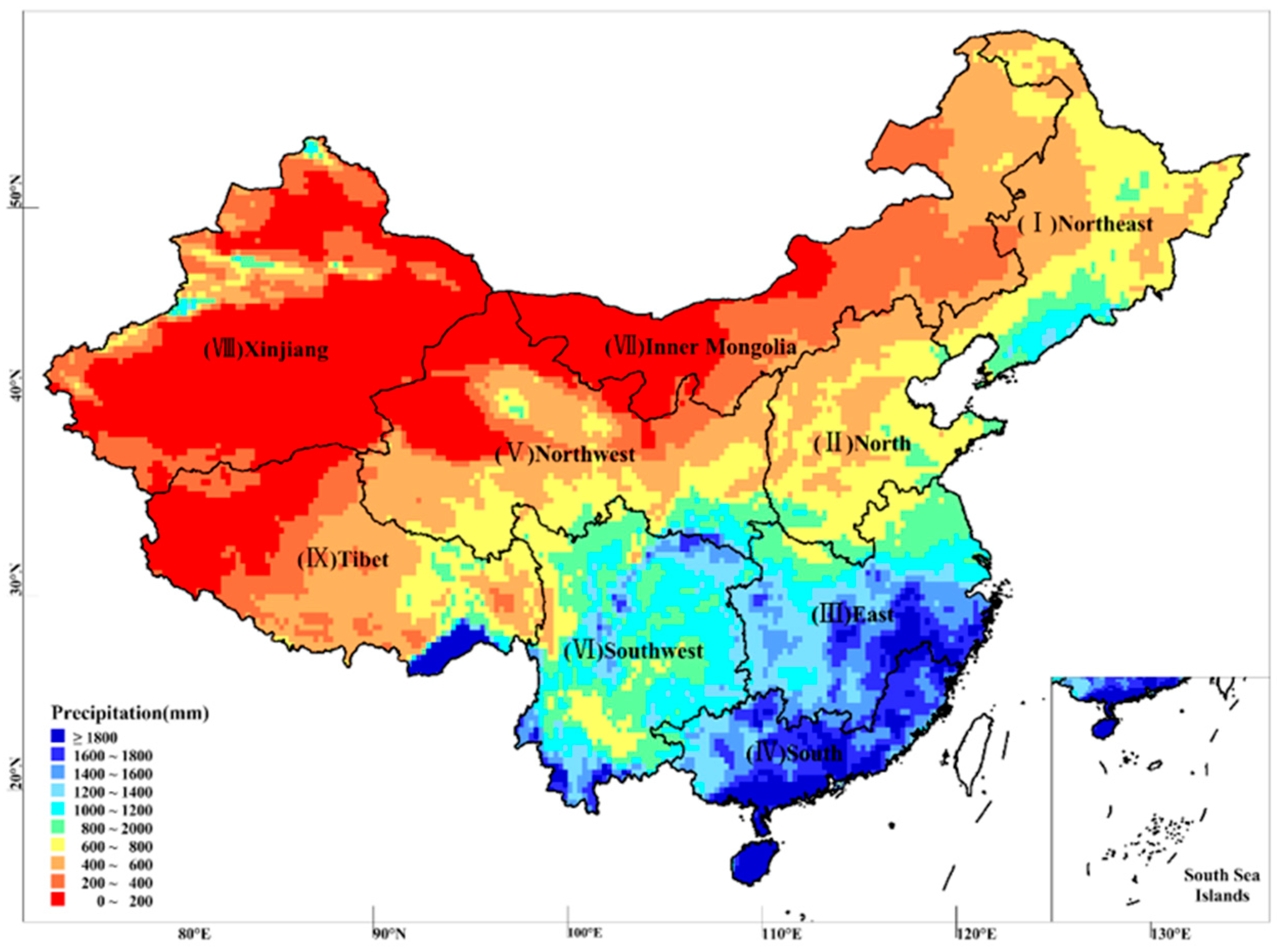
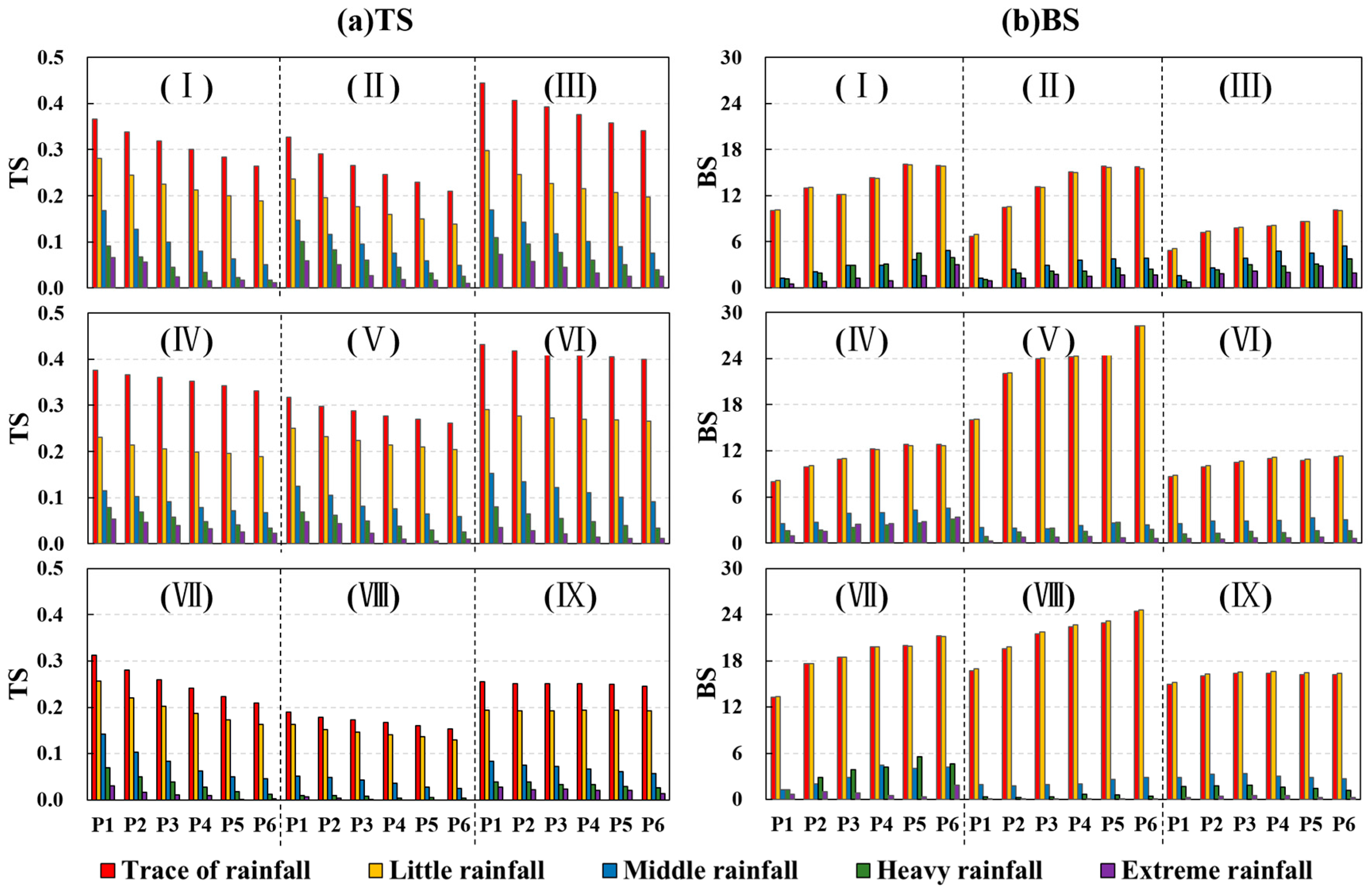
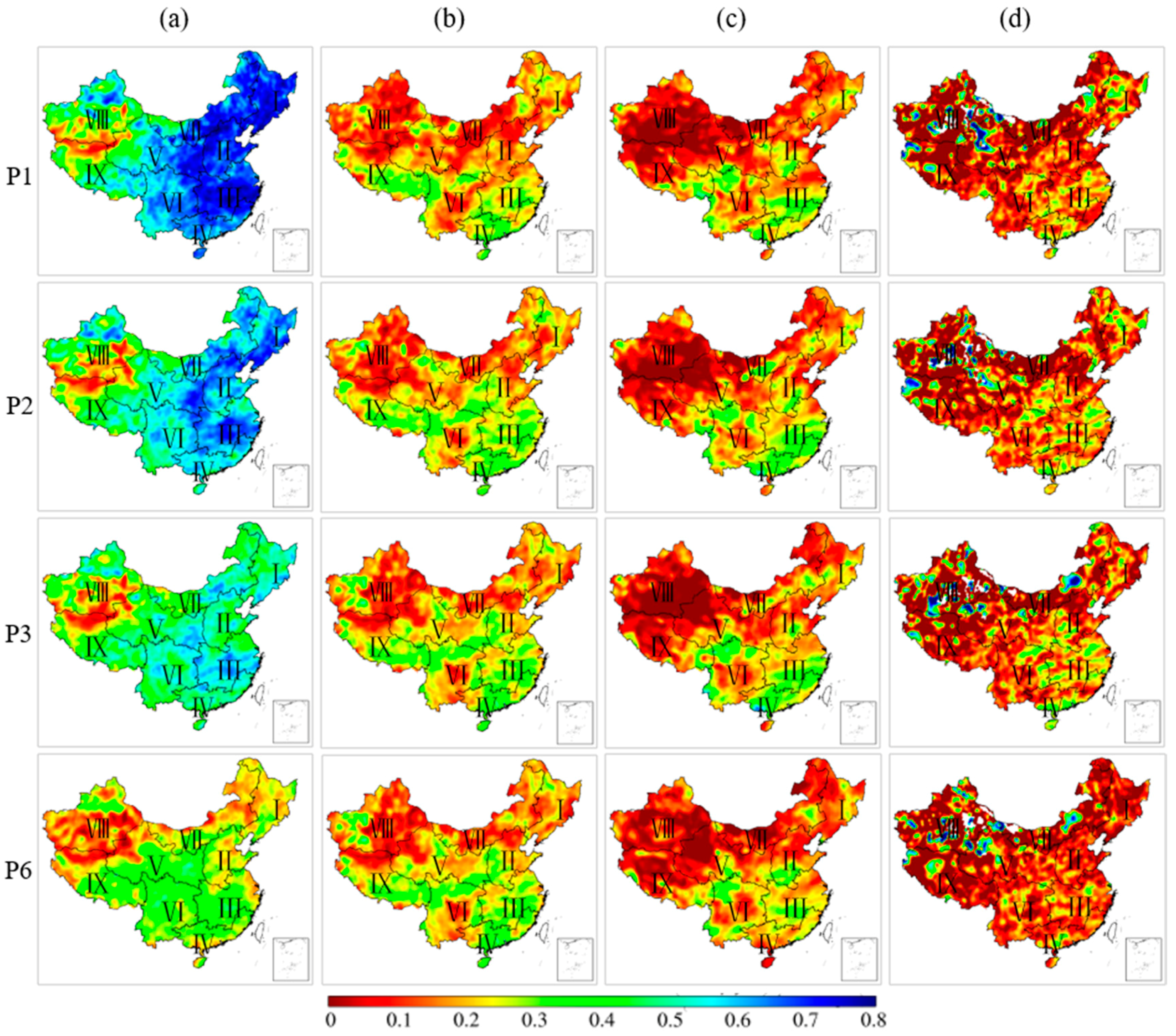
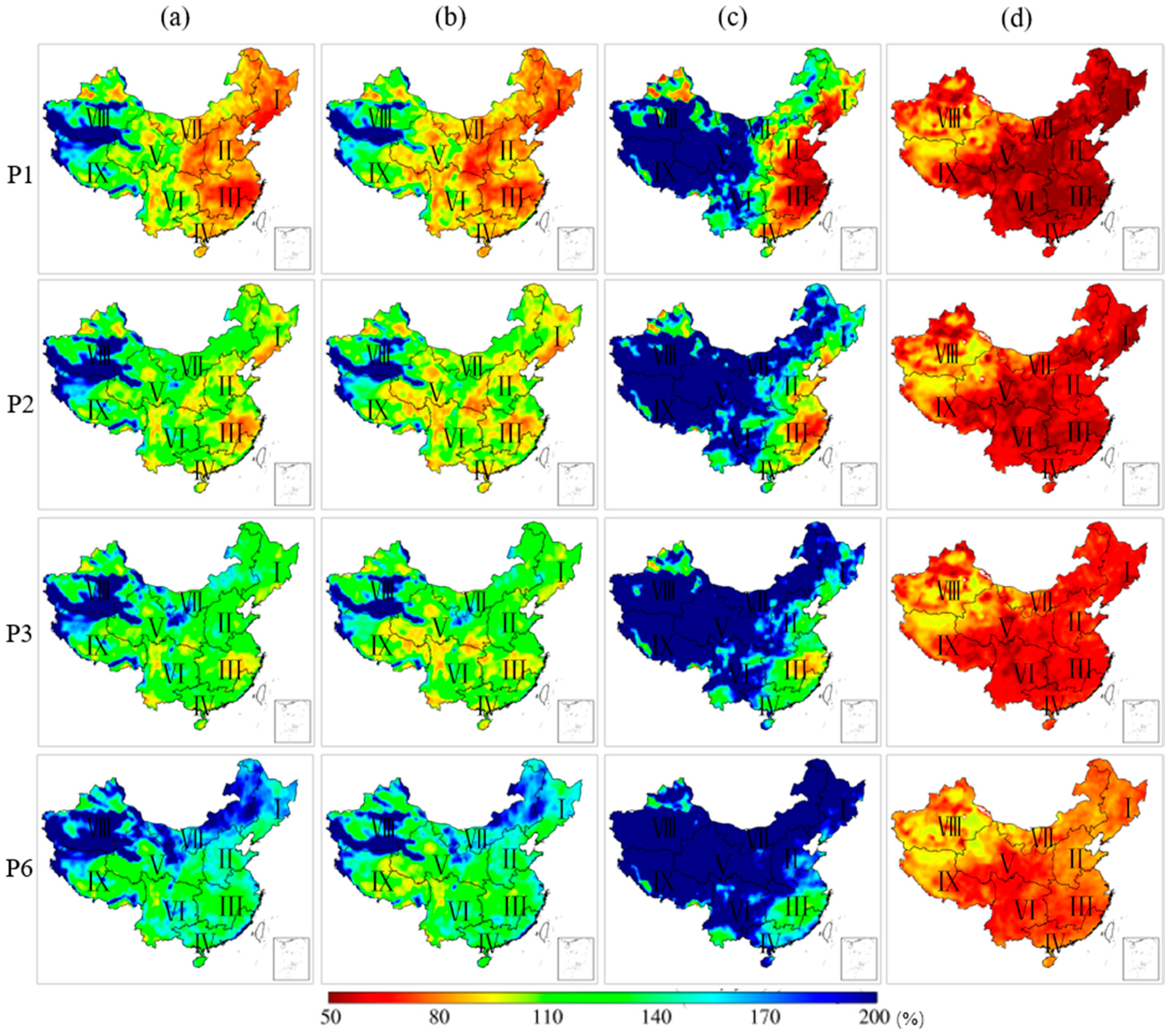
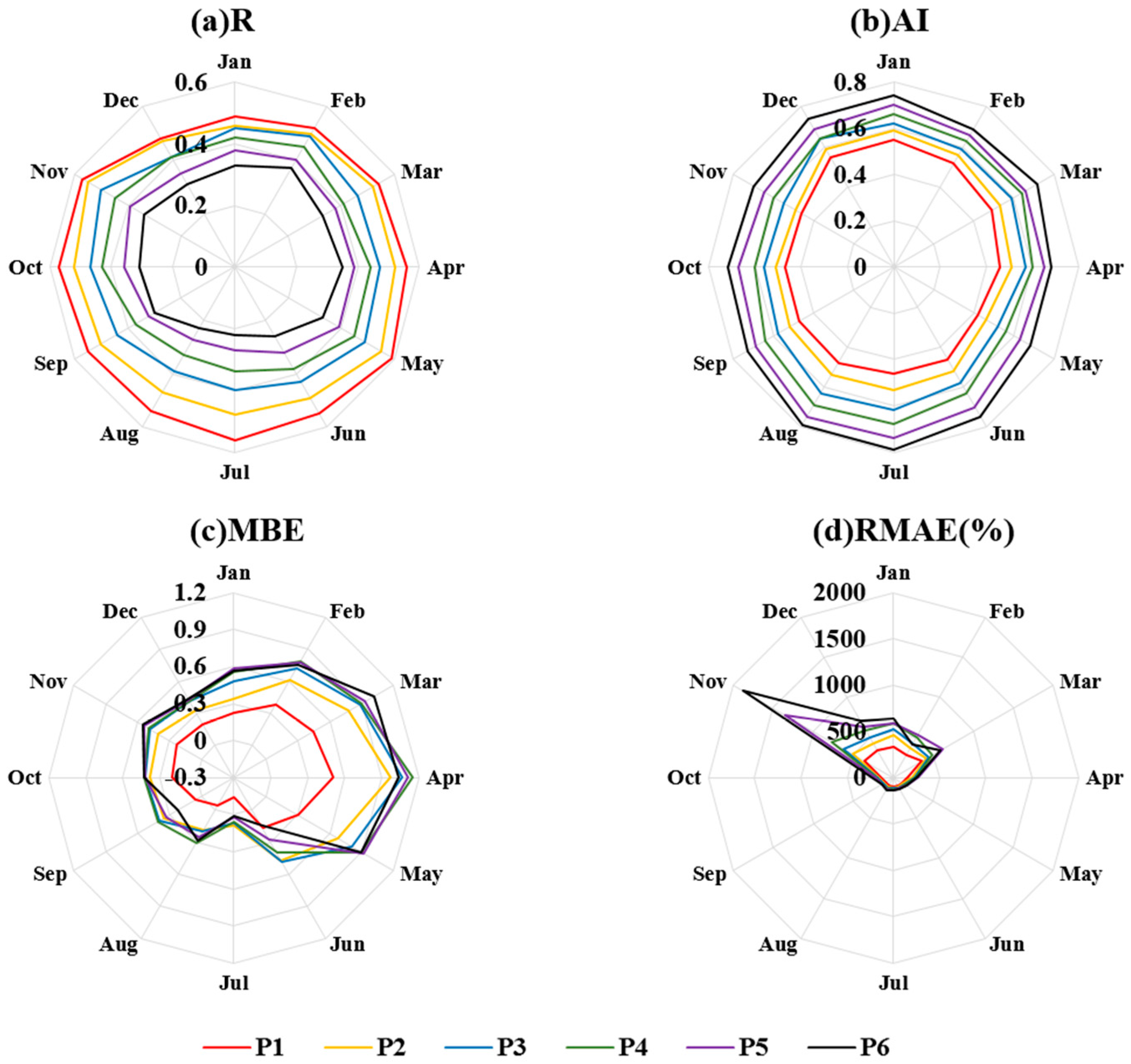
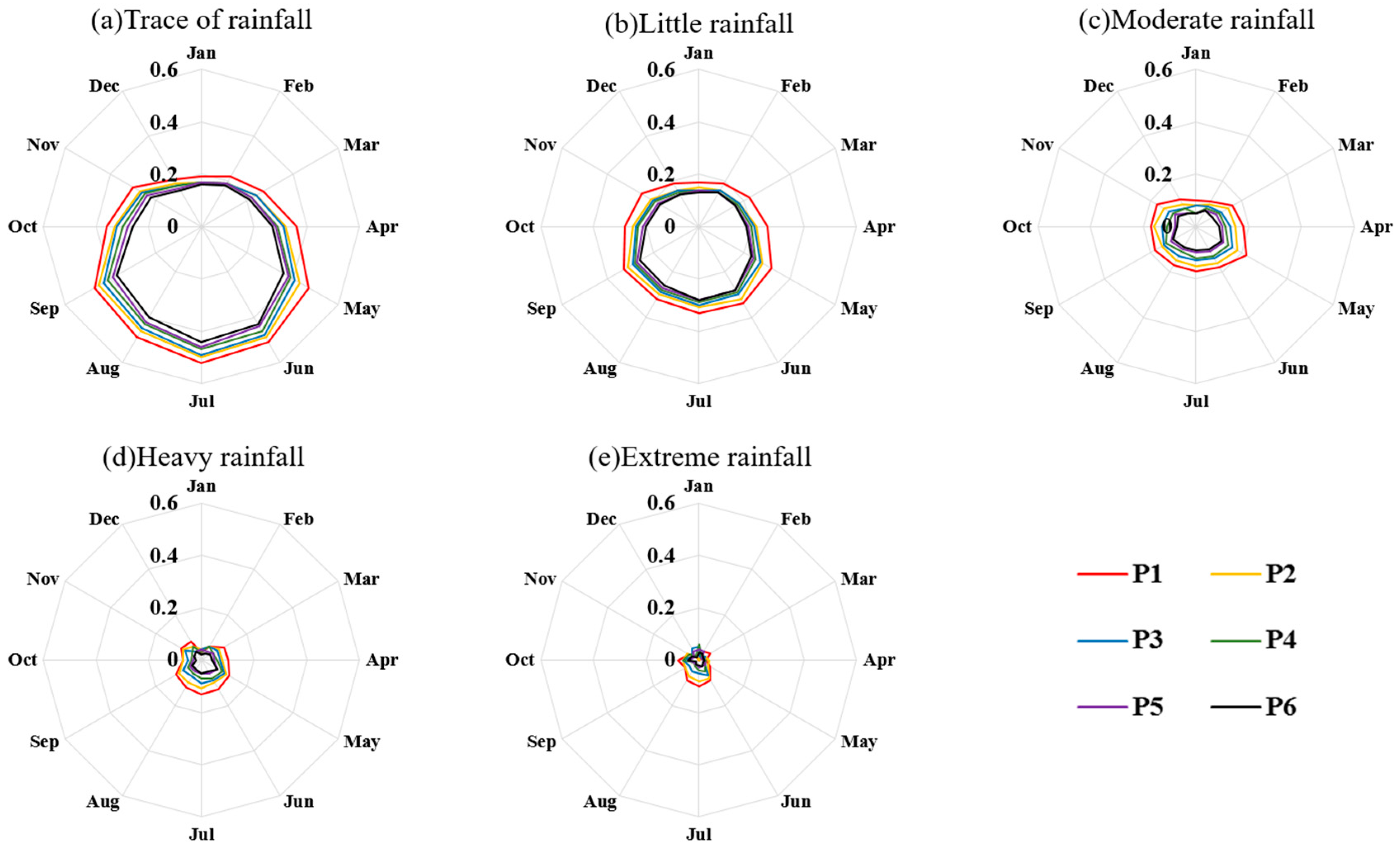
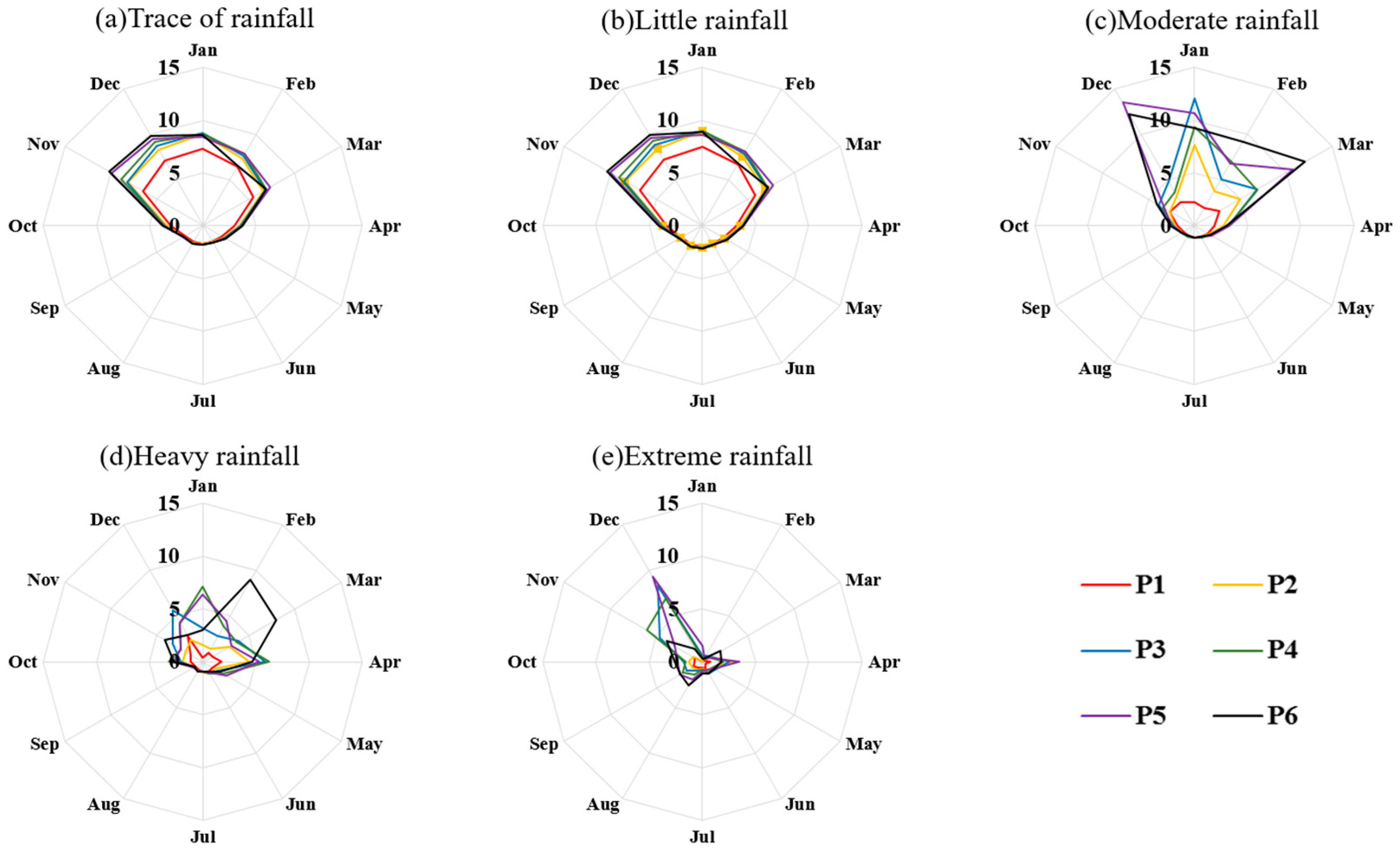
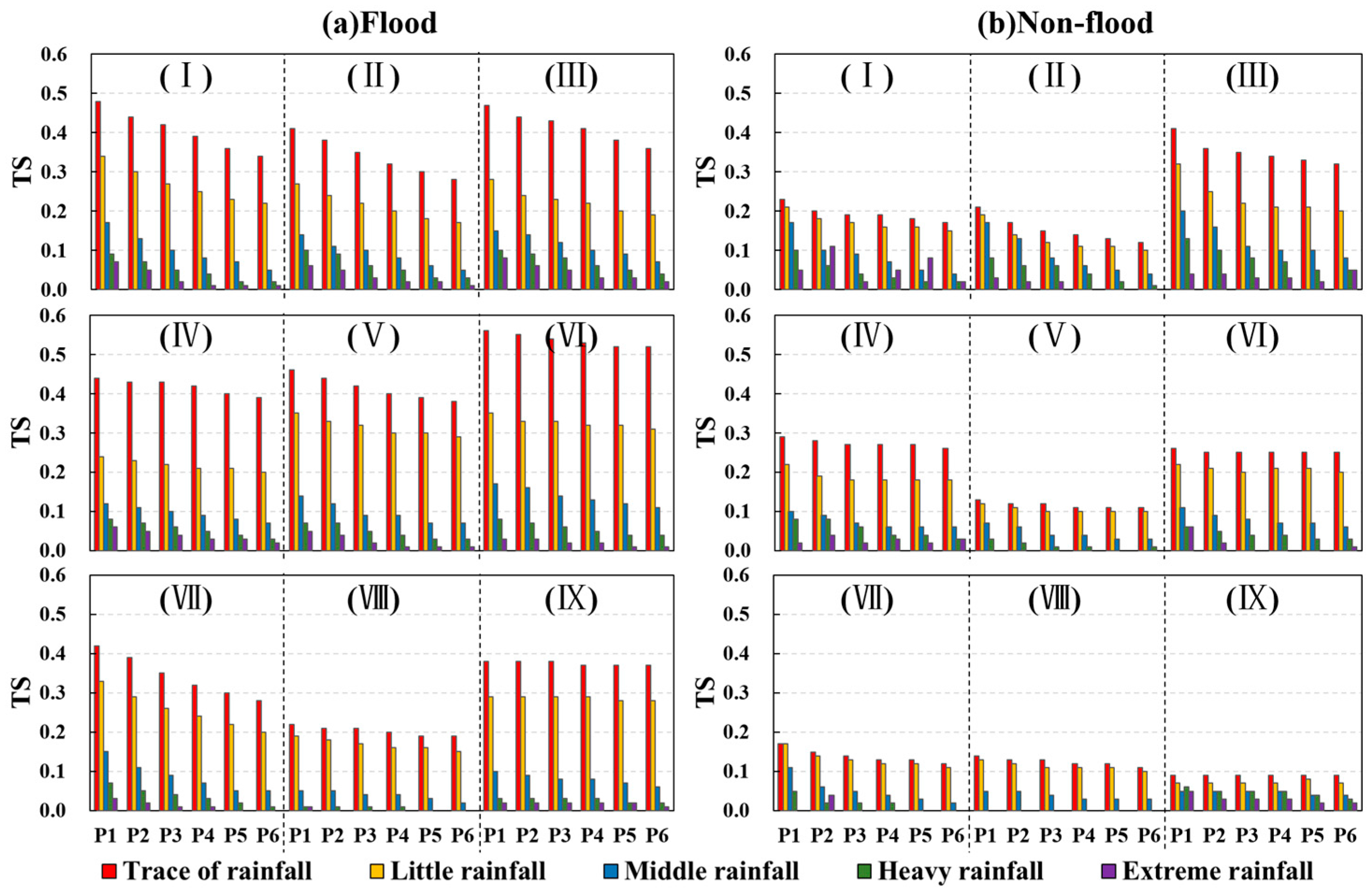
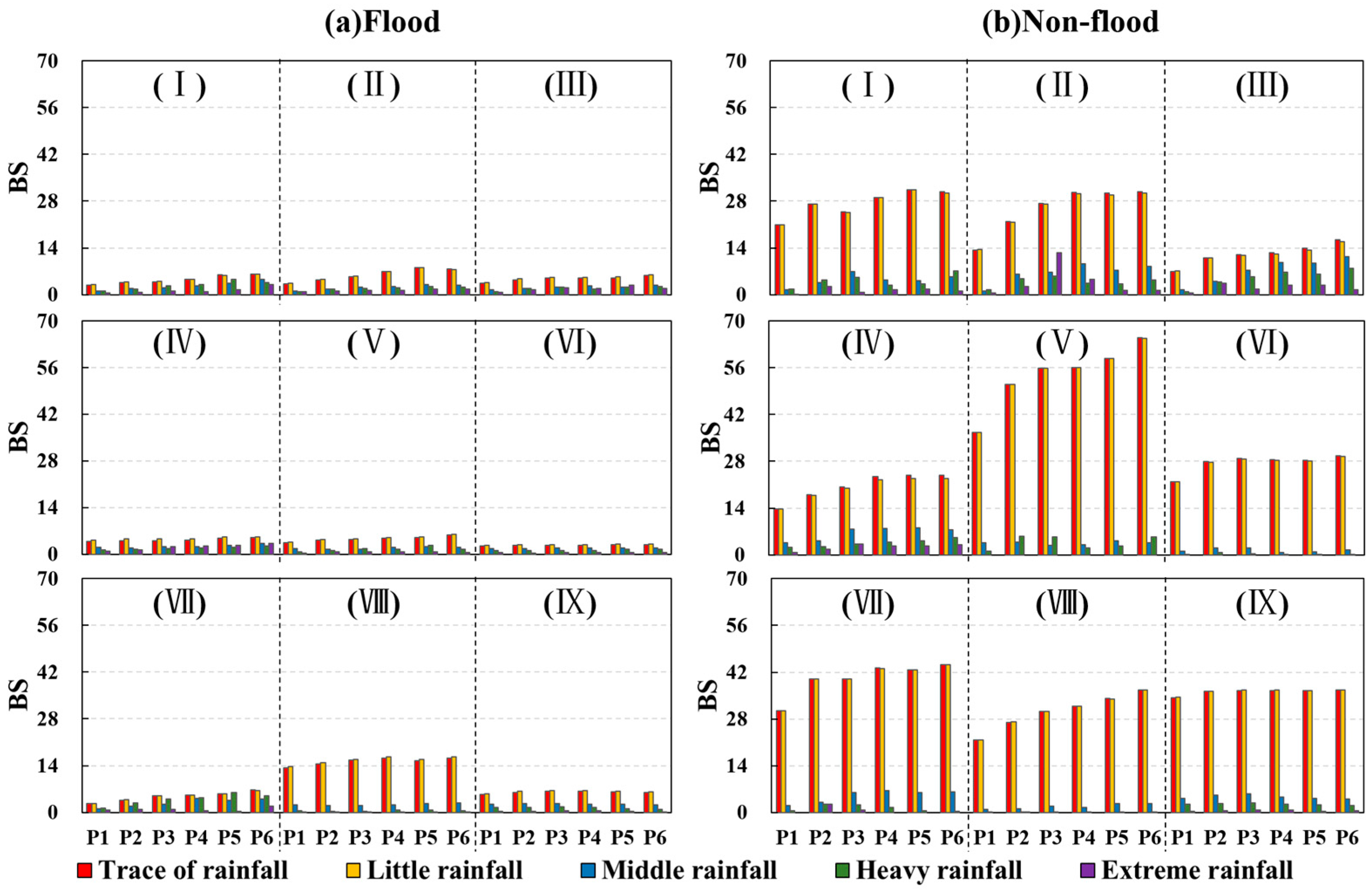
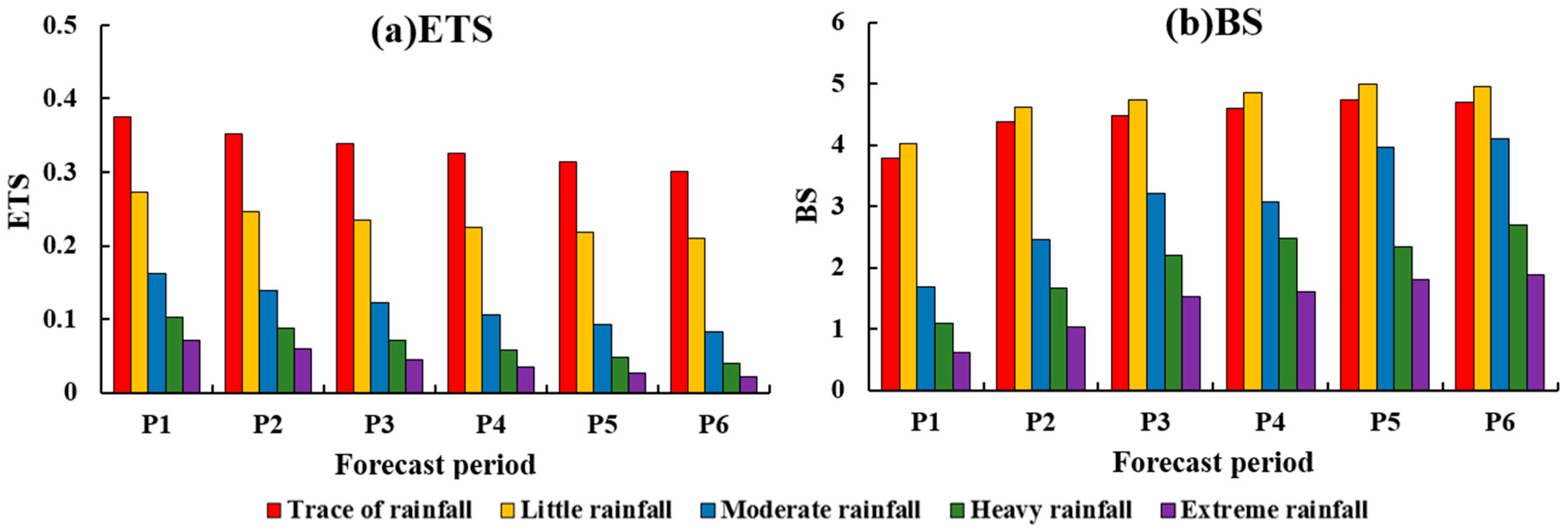

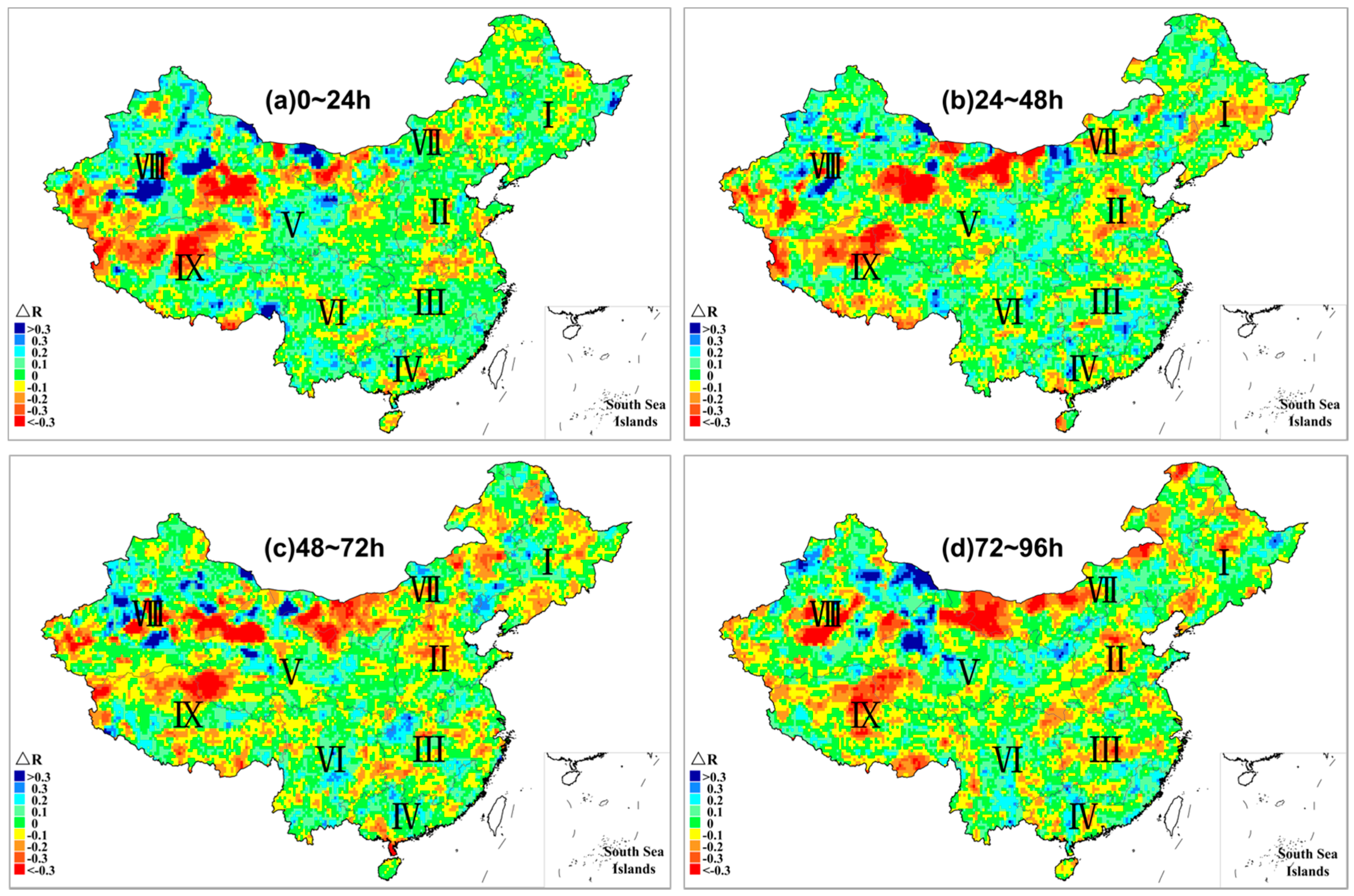
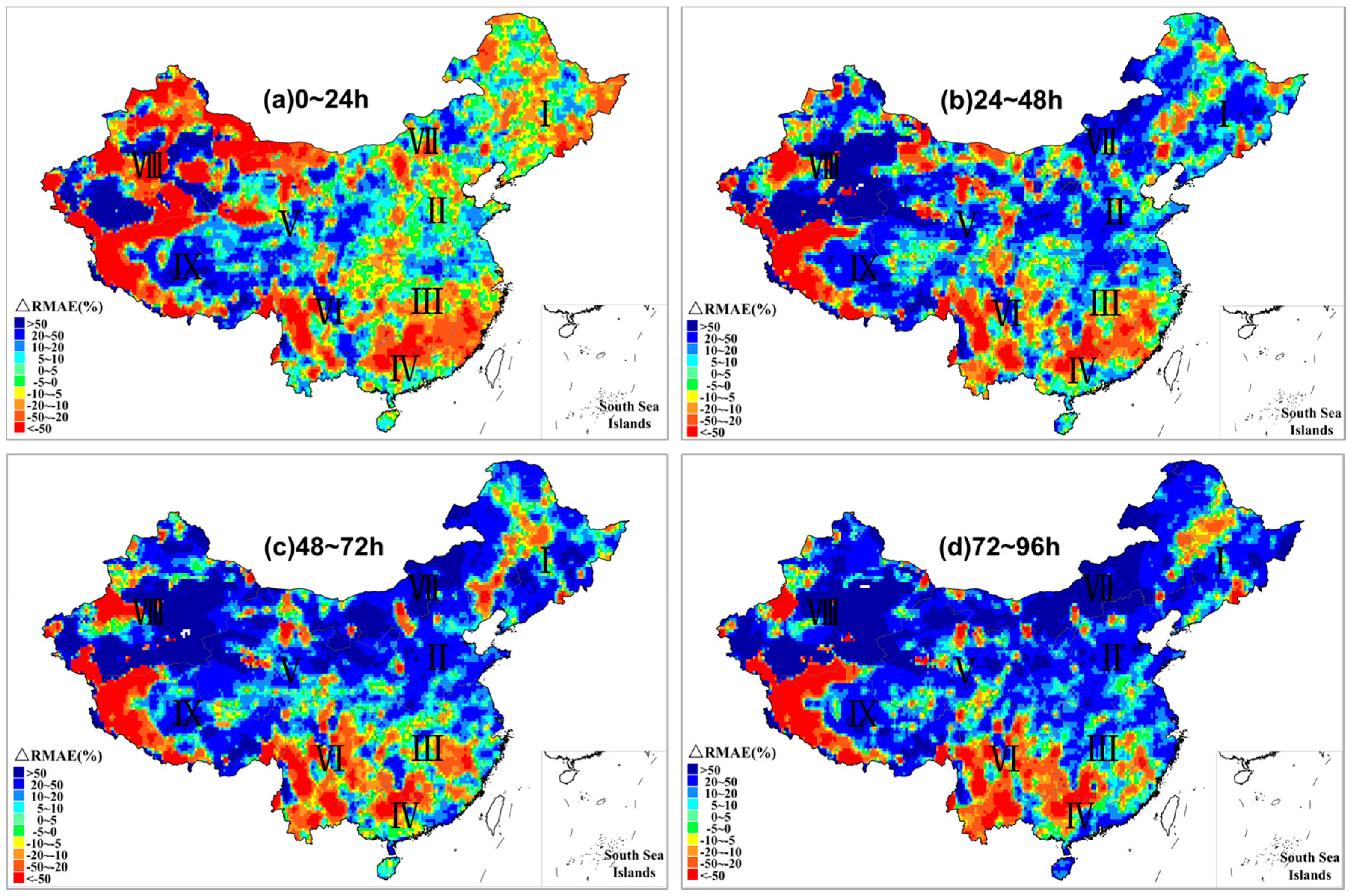
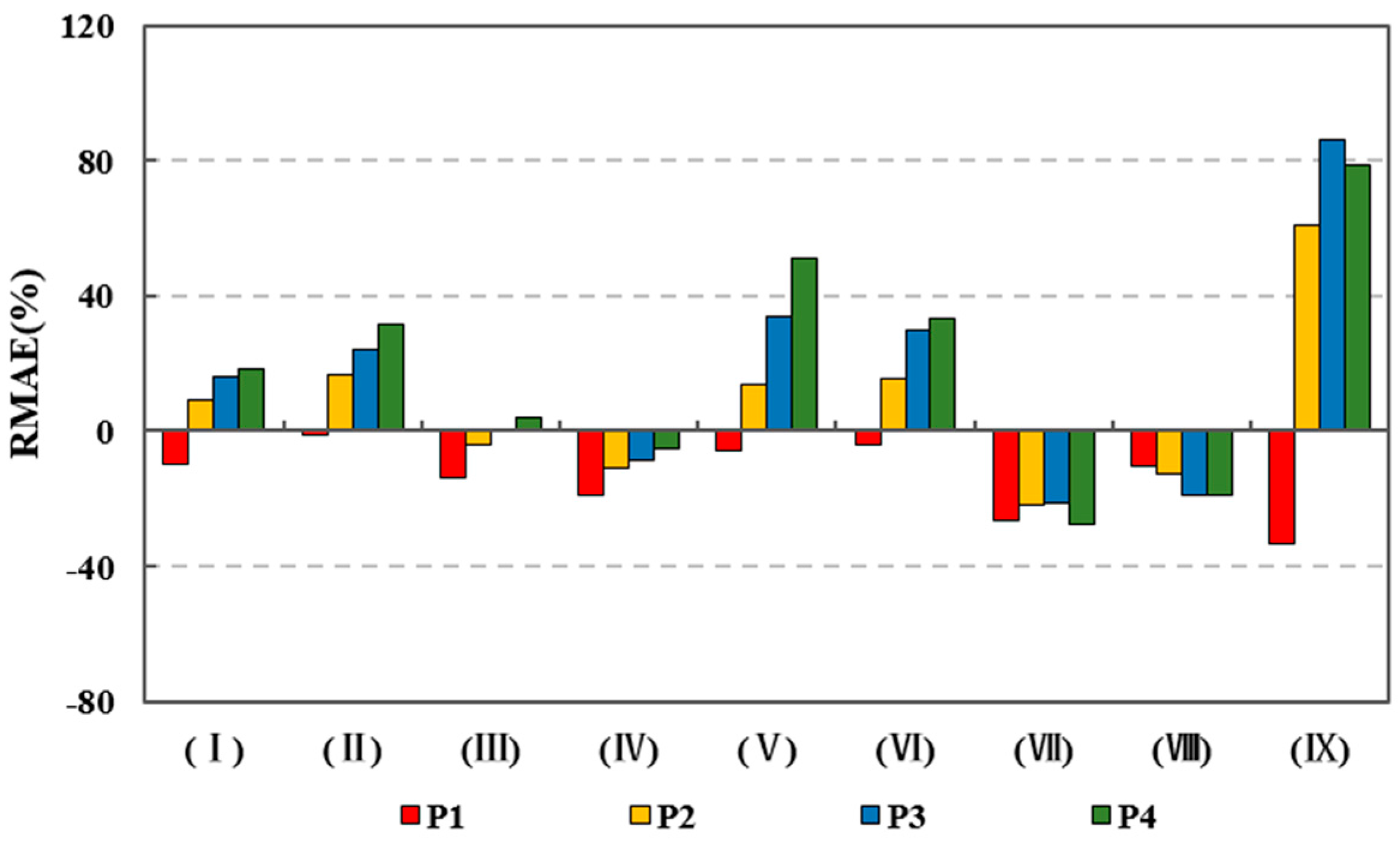
| Observation | |||
|---|---|---|---|
| Yes | No | ||
| Forecast | Yes | NA | NB |
| No | NC | ND | |
© 2018 by the authors. Licensee MDPI, Basel, Switzerland. This article is an open access article distributed under the terms and conditions of the Creative Commons Attribution (CC BY) license (http://creativecommons.org/licenses/by/4.0/).
Share and Cite
Xu, H.; Wu, Z.; Luo, L.; He, H. Verification of High-Resolution Medium-Range Precipitation Forecasts from Global Environmental Multiscale Model over China during 2009–2013. Atmosphere 2018, 9, 104. https://doi.org/10.3390/atmos9030104
Xu H, Wu Z, Luo L, He H. Verification of High-Resolution Medium-Range Precipitation Forecasts from Global Environmental Multiscale Model over China during 2009–2013. Atmosphere. 2018; 9(3):104. https://doi.org/10.3390/atmos9030104
Chicago/Turabian StyleXu, Huating, Zhiyong Wu, Lifeng Luo, and Hai He. 2018. "Verification of High-Resolution Medium-Range Precipitation Forecasts from Global Environmental Multiscale Model over China during 2009–2013" Atmosphere 9, no. 3: 104. https://doi.org/10.3390/atmos9030104
APA StyleXu, H., Wu, Z., Luo, L., & He, H. (2018). Verification of High-Resolution Medium-Range Precipitation Forecasts from Global Environmental Multiscale Model over China during 2009–2013. Atmosphere, 9(3), 104. https://doi.org/10.3390/atmos9030104






